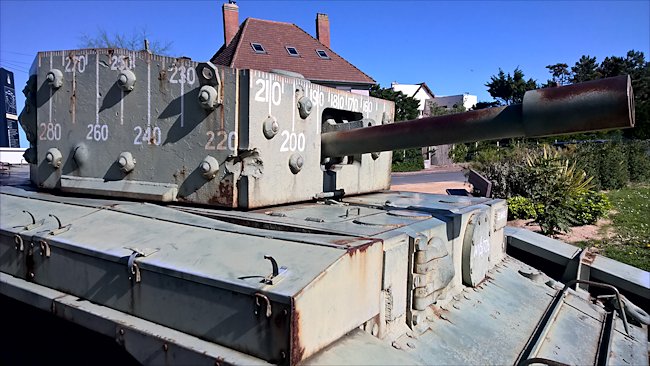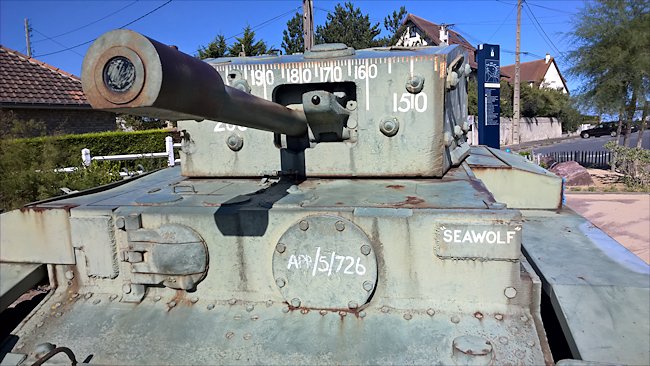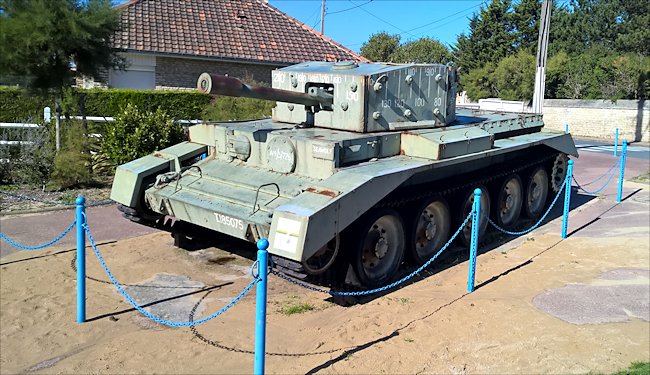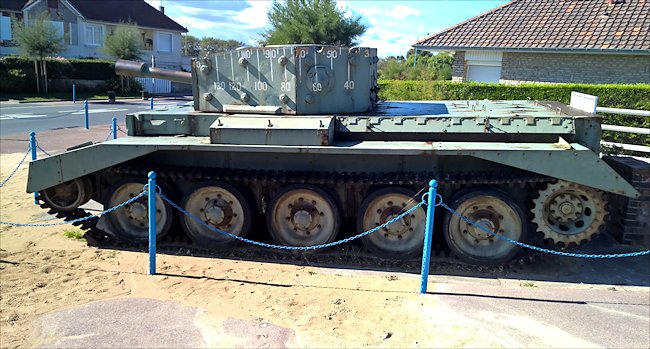Hermanville-sur-Mer Centaur IV Tank
The tank has been painted to look like a British Centaur IV Tank. The Centaur was very similar to the Cromwell tank except it had a different less powerful engine and a 95mm howitzer artillery gun instead of the Cromwell's 75mm anti-tank gun. They were used on D-Day to fire on German beach defences from tank landing craft. The paint has faded. It would either be SCC No.2 (Khaki Brown) or SCC No 15 (Khaki Green).

The 360° North marker was painted at the rear and the 180° marker that indicated South, was at the front.
This tank was originally a Cromwell Dozer, with a bulldozer blade, and was restored at Duxford by the Imperial War Museum with a Cavalier turret which was recovered from the Otternburn firing range in the UK. Some of the fittings of Cromwell Dozer tanks can still be seen on the hull. Marked and restored to appear as a Centaur close support tank of the Royal Marines Armoured Support Group.Location
The British Royal Marine close support Centaur tank can be found along the roadside in Hermanville-sur-Mer where the Avenue Madame Coty meets the with Rue du Dr Turgis and then becomes Rue Amiral Wietzel. There is parking in the road opposite the tank or in the many side roads.
Using a Sat-Nav in the car I initially had difficulty location the tank. The Sat-Nav device navigated me to the Avenue Madam Coty with no problem but all I could see were residential seaside house. If you look at the road plan there is a section of road that looks like rugby ball, an oval. Avenue Madam Coty is the southern road of that oval. The Centaur tank can be found at the eastern end of the oval as you head towards Collevillette and Ouistreham.

Seawolf the A27L Cruiser MK VIII Centaur IV CS (Close Support) tank at Hermanville-sur-Mer in Normandy
Specification
The A27L Cruiser MK VIII Centaur IV CS (Close Support) tank to give it its full name was the Royal Marine Armoured Support Group version of the Centaur tank. It was armed with a 95 mm howitzer that fired high explosive HE shells. Officially 51 HE rounds could be stored inside the tank. It was fitted with wadding gear to enable the tank to get off the tank landing craft and onto the beach safely without getting the engine and crew compartment flooded with sea water. Records show that 114 were produced.
The tank required five crew members: commander, gunner, loader, driver and co/driver. its armour thickness ranged from 20 mm to 76 mm on the turret and hull front. It was powered by a Nuffield Liberty V12 Petrol engine that produced 410 hp. It had a top road speed of 24 mph (40 km/h)
Deployment in Normandy 1944
The Crusader tank that had been used by Commonwealth and British tank crews in the deserts of North Africa needed replacing. It had difficulties knocking out the new up gunned and up armoured Panzer III and Panzer IV tanks that were arriving on the battlefield. The new A27M heavy cruiser tank was going to be built around the Spitfire's Rolls-Royce Merlin aircraft engine. The engine had to be modified for use in a tank and was given the name Meteor. It was the non-supercharged version of the Merlin. The new tank was to be armed with a British 75mm gun and called the Cromwell.
There was a big production problem. There were not enough Rolls-Royce engines available for the amount of tanks ordered. As a stop-gap some of the tanks were fitted with a less powerful engine called the Liberty V-12. These tanks were given the designation A27L Centaur. Some of these tanks would later be retro-fitted with the Meteor engine in Europe.

The Centaur IV close support tank was used by the Royal Marines to attack Sword Beach on D-Day 6th June 1944
The D-Day planners foresaw that there was a need for artillery close support for the troops attacking the beaches. One method to provide this artillery cover was put artillery guns in flat bottomed landing craft that could get close to the beaches. Deploying and firing towed 25pdr artillery Howitzers on a boat was problematic. The solution was to fit a 95mm Howitzer into the Centaur Tank. It would provide a relatively stable gun platform because of the weight of the tank.
Because the tank would be hidden inside the walls of the tank landing craft a way was needed to be able to direct fire on German beach defence targets that were visible from the boat. This is why the Centaur tank at Hermanville-sur-Mer has the degrees of a compass painted on its turret. The 360° North marker was painted at the rear and the 180° marker that indicated South, was at the front.

The Centaur tank is similar to the Cromwell tank except it had a different engine and gun.
The Royal Marine spotter outside the tank would call out the degree and distance to the target and the tank gunner would fire blind over the front of the landing craft ramp. These specialised Centaur tanks were part of the Royal Marines Armoured Support Group that attacked Sword Beach on D-Day.
The tank on display at Hermanville sur Mer was originally built as a Centaur Dozer not a CS (close support) tank. It was fitted with a bulldozer blade to help remove beach obstacles and make a path off the beach for all the supply vehicles that were to follow the first wave of attacking infantry and tanks.
This tank was restored at the Imperial War Museum Duxford. A decision was made to convert it into a Centaur CS (close Support) tank to honour the role played by the Royal Marines in the attack on Sword Beach on D-Day. The turret is a Cavalier turret that was recovered from the Otternburn firing range in the UK. A few fittings from its previous life as a dozer tank can still be seen on the hull.
On D-Day the coastal seaside resort of Hermanville-sur-Mer was part of the British Sector Sword Beach. The coastal defences and the town were bombed by the Allied air forces and later by large Naval guns. Special tanks were landed on the beach to clear the mine fields and concrete obstructions to help the attacking infantry. It was the 1st Battalion of the South Lancashire Regiment that liberated what was left of Hermanville-sur-Mer at 10am along with the men of the 2nd and 5th Battalions of the East Yorkshire Regiment. The Suffolk Regiment liberated the nearby town of Colleville.
D-Day 1944 books

